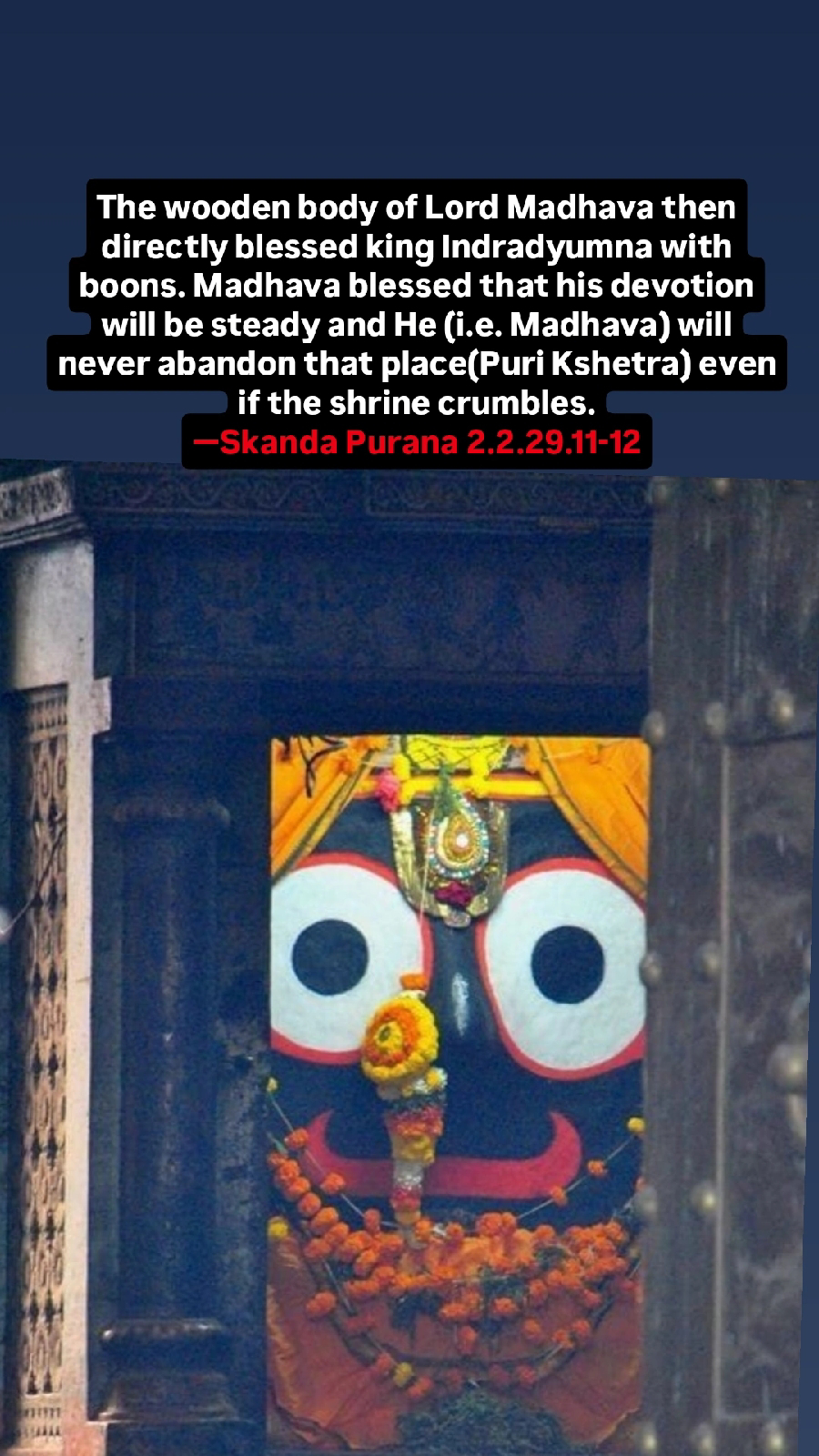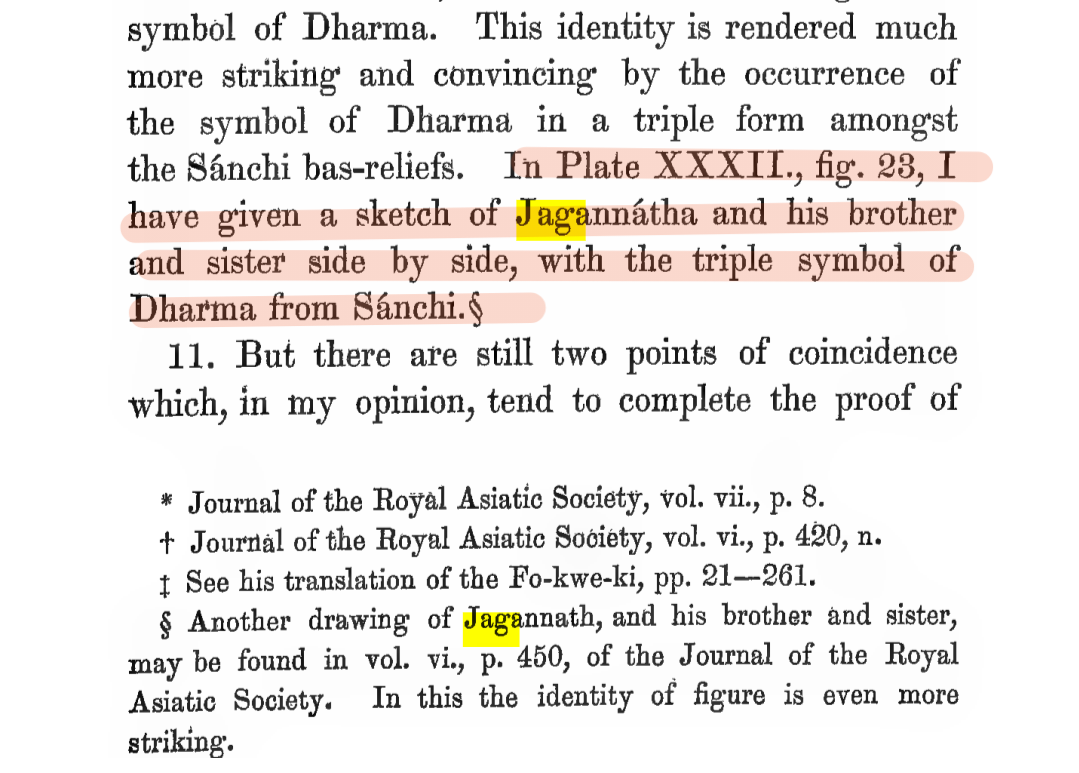Jagannath is undoubtedly a Hindu deity not a Buddhist one
Regarding the origins of Jagannath, some argue it was connected with Buddhists, jainism or even tribal roots, all these colonial era propagandas are intent to disassociate Jagannath from Hindu faith. Let analyse each & every claim critically.
Swami Vivekanandas views misrepresented:-
"...the temple of Jagannath is an old Buddhistic temple. We took this and
others over and re-Hinduised them."
Source: Lectures from Colombo to Almora (2008), Advaita Ashrama, pp 188-189
This statement itself shows people didn't read the statement properly look he said "Re-hinduised" which means it was once occupied by Buddhists from Hindus & later we again Re-hinduised it.
Even this interpretation find support from Historical documents as well.
Book Annals and Antiquities of the Temple of Jagannātha
By Narayan Miśra said:-
"the Buddhists "seized the Jagannath temple..and turned it into a shrine of their own under the system of Buddhist idolatry"
for nearly three centuries .."
Vedic origins & connection with Jagannath:-
Great 14th century CE Vedic commentator Sayanacharya mention Vedic connection of Jagannath
Even Puri natives do call Jagannatha as Purushottama, consider driftwood a savior symbol. Vedic connection is hence well supported.
Hindu Scriptural mention of Jagannath, Balaram & Shubhadra :-
महावेदीं व्रजंतं तं रथस्थं पुरुषोत्तमम् ।
बलभद्रं सुभद्रां च जन्मकोटिसमुद्भवम् ॥
~Skanda Purana 2.2.33.59
By witnessing Puruṣottama, Subhadrā and Balabhadra seated in the chariot and proceeding towards the Great Altar, the devotee dispels the sin committed in crores of births.
Similar murtis other than Jagannath Mandir:-
Final blow here you can see the earliest known triad(Balarama, Shubhadra & Jagannath)
Vrishni triad shown in a rock painting at Tikla, Madhya Pradesh, 3rd-2nd century BCE. These would be Balarama, Vāsudeva and the female deity Ekanamsha(Subhadra).
Vasudeva-Krishna, Ekanamsa, and Balarama within a Roman arch as was found in Berenike- Egypt, inside an ISIS temple, dated 2nd century CE.
This is from 9th Century CE from UP
Balaram, Ekanansa(Subhadra) & Krishna
So from all these it is crystal clear these triad have no connection with Buddha from earlier times.
Was Jagannath was actually Narasimha Deva ?
Narasimha was the original deity of Puri- as per Prof. Alexis Sanderson.
Even if I take this one, it proves the point that the temple was always a Hindu temple.
The Puri temple has many core Pancharatric elements for example the vana-yAga with the 400 syllabled Patala Narasimha mantra that occurs in Navakalevara which is taken from the vidhi of Hayashirsha pancharatra(also described in Hari Bhakti Vilasa).
However Patala Narasimha yaga has to be done for extracting the stone from the ground. It has more to do with siddhis of extracting treasures from the ground. Applies for all vigrahas of Vishnu not just identification with Narasimha. In Navakalevara it is done before proceeding to cut the wood for making the new vigrahas of the triads. They do the ritual prior to cutting the specific trees.
Is Brahmapadartha in Jagannath was Buddha's relic(tooth) ?
The origin of this claim comes from The Dāṭhavaṃsa which is a Pali chronicle attributed to Dhammakitti Thero, written around the 13th century, though based on an earlier Sinhala text, the Dalada-vamsa. It details the history of the Buddha’s tooth relic, focusing on its journey from India to Sri Lanka.According to the Dāṭhavaṃsa and the Mahāvaṃsa, after the Buddha’s cremation, his left canine tooth was retrieved by his disciple Khema and given to King Brahmadatta of Kalinga, where it was venerated at Dantapura (modern Dantapuram, in present-day Andhra Pradesh or Odisha). The text recounts how the relic was later moved to Sri Lanka during the reign of King Sirimeghavanna (or Kirti Sri Meghavanna) in the 4th century CE, following conflicts in Kalinga, to ensure its safety.
the Chinese pilgrim Faxian (c. 400 CE) described a tooth relic procession in Kalinga, which some scholars link to the Jagannath Ratha Yatra, though this is not definitive evidence of the relic remaining in Puri.
The Dāṭhavaṃsa explicitly states that the tooth relic was taken to Sri Lanka, not left in Puri. This is corroborated by other sources like the Mahāvaṃsa and accounts by Faxian, who describe the relic’s veneration in Sri Lanka.
Now the question is Does the Dāṭhavaṃsa Mention Jagannath?
The Dāṭhavaṃsa does not explicitly state that the Buddha’s tooth relic is encased in the Jagannath idol at Puri. It primarily traces the relic’s history from Kalinga to Sri Lanka, where it is enshrined at the Temple of the Tooth in Kandy.The text details events such as the relic’s veneration in Dantapura, a war over its possession between King Guhasiva of Kalinga and King Pandu, and its eventual transfer to Sri Lanka by Hemamala and Dantakumara. There is no reference in the Dāṭhavaṃsa to the relic being placed in the Jagannath idol or remaining in Puri.
Debunking the false claim Cunningham found Jagannath statue under Sanchi stupa :-
Claim:-
This is a perfect example of dishonesty & lie, let debunk this and let me show how misinformation spread by leftists & Ambedkarites. The answer lies in the source he share:-
He seem to have some comprehension issue , Cunningham here says it's the fig. 22 which was found at Sanchi not that Jagannath image in fig. 23
Here he compared it's similarity with Jagannath.
Fig 23 is just a sketch of Jagannath given by Cunningham for comparison with fig 22
Jagannath Mandir & Jagannath is undoubtedly a Hindu deity :-
Buddhist arguments in a nutshell:-
The final blow & the last pin in the coffin:-
Regarding Rath yatra, alleged Buddha's tooth:-
Conclusion:-
Source:- https://magazines.odisha.gov.in/Orissareview/2014/Jun/engpdf/85-89.pdf











Comments
Post a Comment